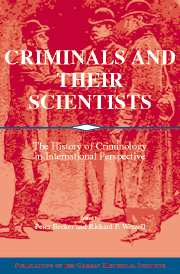Book contents
- Frontmatter
- Introduction
- Part One Nonacademic sites of Nineteenth-Century Criminological Discourse
- Part Two Criminology as Scientific and Political Practice in the Late Nineteenth and Early Twentieth Centuries
- Part Three The Making of the Criminologist
- 13 The International Congresses of Criminal Anthropology: Shaping the French and International Criminological Movement, 1886-1914
- 14 Making Criminologists: Tools, Techniques, and the Production of Scientific Authority
- 15 “One of the Strangest Relics of a Former State”: Tattoos and the Discourses of Criminality in Europe, 1880-1920
- 16 What Criminals Think about Criminology: French Criminals and Criminological Knowledge at the End of the Nineteenth Century
- 17 Talk of the Town: The Murder of Lucie Berlin and the Production of Local Knowledge
- Part Four Criminology in the First Half of the Twentieth Century: The Case of Weimar and Nazi Germany
- Index
14 - Making Criminologists: Tools, Techniques, and the Production of Scientific Authority
Published online by Cambridge University Press: 05 January 2013
- Frontmatter
- Introduction
- Part One Nonacademic sites of Nineteenth-Century Criminological Discourse
- Part Two Criminology as Scientific and Political Practice in the Late Nineteenth and Early Twentieth Centuries
- Part Three The Making of the Criminologist
- 13 The International Congresses of Criminal Anthropology: Shaping the French and International Criminological Movement, 1886-1914
- 14 Making Criminologists: Tools, Techniques, and the Production of Scientific Authority
- 15 “One of the Strangest Relics of a Former State”: Tattoos and the Discourses of Criminality in Europe, 1880-1920
- 16 What Criminals Think about Criminology: French Criminals and Criminological Knowledge at the End of the Nineteenth Century
- 17 Talk of the Town: The Murder of Lucie Berlin and the Production of Local Knowledge
- Part Four Criminology in the First Half of the Twentieth Century: The Case of Weimar and Nazi Germany
- Index
Summary
introduction
A number of studies over the past twenty years have focused on the production of “the criminal” in the late nineteenth century - on the discursive construction, that is, of a new object of both scientific knowledge and sociotechnical intervention. This chapter focuses, in a complementary fashion, on the production of the criminologist - on the fashioning of a new kind of scientific expert qualified to read the criminal body and diagnose social dangers. In fact, it might be more apt, as the title of this volume suggests, to speak of the co-production of criminals and scientists. Criminal anthropology's claims to the status of science were, on one hand, dependent on the presence of bodies that lent themselves to a discriminating quantification: In the laboratory, the prison, the university lecture hall, and the courtroom the anthropologist would be required to point with some measure of confidence to bodies that were marked off from the normal, or that announced their dangerousness. At the same time, the facticity of “the criminal body” was dependent on the authority of figures like Cesare Lombroso, who in publications and in testimony before juries had to struggle to contain the variability of real bodies’ surfaces, to overcome criminals’ multiple forms of resistance to scrutiny, and to disqualify competing claims of knowledge. And this scientific authority, I suggest, had much to do with the practical abilities of physicians and others to regularize tools and measurements, to stabilize interpretations, and to deploy the rhetoric of the “expert.”
- Type
- Chapter
- Information
- Criminals and their ScientistsThe History of Criminology in International Perspective, pp. 317 - 336Publisher: Cambridge University PressPrint publication year: 2006
- 1
- Cited by

